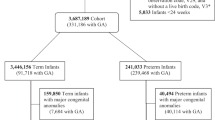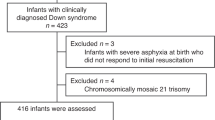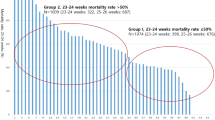Abstract
Objectives:
The objectives of this study were (1) to compare age at death and the intensity and cost of medical treatment for infants diagnosed prenatally or postnatally with congenital anomalies considered to be lethal. (2) To determine whether greater treatment intensity is associated with longer life.
Study Design:
This is a retrospective cohort study of all fetuses and neonates with congenital anomalies classified as lethal who were diagnosed or treated at the University of North Carolina Hospitals from January 1998 to December 2003.
Result:
The cohort consisted of 192 fetuses and infants: 160 were diagnosed prenatally, 2 were diagnosed perinatally, and 30 were diagnosed postnatally. In all, 115 (72%) pregnancies were terminated. Of the liveborn infants, 75% died before 10 days of age and 90% before 4 months of age. Compared with postnatally diagnosed infants, prenatally diagnosed infants received less intense treatment (median average daily Neonatal Therapeutic Intervention Scoring System score 8.3 versus 14.0; P=0.02), at less cost (median direct cost of hospitalization $1550 versus $8474; P=0.03) and died sooner (median age at death <1 day versus 4 days; P=0.01). Greater treatment intensity did not correlate with longer survival (r=−0.04; P=0.66).
Conclusion:
Although some kinds of medical therapy may be appropriate for newborns with lethal congenital anomalies, highly aggressive interventions did not prolong survival and should not be offered. Even when pregnancy termination is not elected, infants diagnosed prenatally receive less intense care.
This is a preview of subscription content, access via your institution
Access options
Subscribe to this journal
Receive 12 print issues and online access
$259.00 per year
only $21.58 per issue
Buy this article
- Purchase on Springer Link
- Instant access to full article PDF
Prices may be subject to local taxes which are calculated during checkout



Similar content being viewed by others
References
Peller AJ, Westgate MN, Holmes LB . Trends in congenital malformations, 1974 to 1999: effect of prenatal diagnosis and elective termination. Obstet Gynecol 2004; 104: 957–964.
Greenhouse L . Court order to treat baby with partial brain prompts debate on costs and ethics. The New York Times, 20 February 1994, Sect. 1.
Clark PA . Medical futility in pediatrics: is it time for a public policy? J Public Health Policy 2002; 23: 66–89.
McGraw MP, Perlman JM . Attitudes of neonatologists toward delivery room management of confirmed trisomy 18: potential factors influencing a changing dynamic. Pediatrics 2008; 121: 1106–1110.
United States Department of Health and Human Services. The International Classification of Diseases, Ninth revision, Clinical Modification: ICD-9-CM 1991. Available from http://www.cdc.gov/nchs/icd/icd9cm.htm.
Barnes AM, Chang W, Morello R, Cabral WA, Weis M, Eyre DR et al. Deficiency of cartilage-associated protein in recessive lethal osteogenesis imperfecta. N Engl J Med 2006; 355: 2757–2764.
Chen H, Liu CT, Yang SS . Achondrogenesis: a review with special consideration of achondrogenesis type II (Langer-Saldino). Am J Med Genet 1981; 10: 379–394.
Connor JM, Connor RA, Sweet EM, Gibson AA, Patrick WJ, McNay MB et al. Lethal neonatal chondrodysplasias in the West of Scotland 1970 to 1983 with a description of a thanatophoric, dysplasialike, autosomal recessive disorder, Glasgow variant. Am J Med Genet 1985; 22: 243–253.
Potter EL . Bilateral absence of ureters and kidneys: a report of 50 cases. Obstet Gynecol 1965; 25: 3–12.
Scott JE . Fetal, perinatal, and infant death with congenital renal anomaly. Arch Dis Child 2002; 87: 114–117.
Weissman A, Diukman R, Auslender R . Fetal acrania: five new cases and review of the literature. J Clin Ultrasound 1997; 25: 511–514.
Jaquier M, Klein A, Boltshauser E . Spontaneous pregnancy outcome after prenatal diagnosis of anencephaly. BJOG 2006; 113: 951–953.
Rasmussen SA, Wong LY, Yang Q, May KM, Friedman JM . Population-based analyses of mortality in trisomy 13 and trisomy 18. Pediatrics 2003; 111: 777–784.
Hasegawa T, Harada N, Ikeda K, Ishii T, Hokuto I, Kasai K et al. Digynic triploid infant surviving for 46 days. Am J Med Genet 1999; 87: 306–310.
Lee K, Khoshnood B, Chen L, Wall SN, Cromie WJ, Mittendorf RL . Infant mortality from congenital malformations in the United States, 1970 to 1997. Obstet Gynecol 2001; 98: 620–627.
Rodriguez MM, Reik RA, Carreno TD, Fojaco RM . Cluster of iniencephaly in Miami. Pediatr Pathol 1991; 11: 211–221.
Jones KL . Smith's Recognizable Patterns of Human Malformation. 6th edn. Elsevier Saunders: Philadelphia, 2006.
Online Mendelian Inheritance in Man, OMIM (TM). McKusick-Nathans Institute of Genetic Medicine, Johns Hopkins University (Baltimore, MD) and National Center for Biotechnology Information, National Library of Medicine (Bethesda, MD) (cited 14 June 2005); available from http://www.ncbi.nlm.nih.gov/omim.
Jeanty P . TheFetus.net (cited 14 July 2005); available from http://www.thefetus.net/index.php.
Gray JE, Richardson DK, McCormick MC, Workman-Daniels K, Goldmann DA . Neonatal therapeutic intervention scoring system: a therapy-based severity-of-illness index. Pediatrics 1992; 90: 561–567.
McAbee GN, Chan A, Erde EL . Prolonged survival with hydranencephaly: report of two patients and literature review. Pediatr Neurol 2000; 23: 80–84.
Trisomy 18 Foundation. Trisomy 18 foundation forum: children that live, ages & how are they developmentally. (cited 25 March 2007); available from http://trisomy18support.org/modules/newbb/viewtopic.php?topic_id=5923&forum=41.
Living with Trisomy 13. Trisomy 13 syndrome—Photos, videos & updates of children living with Trisomy 13. (cited 25 March 2007); available from http://www.livingwithtrisomy13.org/trisomy-13.htm.
Aytar MH, Dogulu F, Cemil B, Ergun E, Kurt G, Baykaner K . Iniencephaly and long-term survival: a rare case report. Child Nerv Syst 2007; 6: 719–721.
Kaneko Y, Kobayashi J, Yamamoto Y, Yoda H, Kanetaka Y, Nakajima Y et al. Intensive cardiac management in patients with trisomy 13 or trisomy 18. Am J Med Genet 2008; 146: 1372–1380.
Kosho T, Nakamura T, Kawame H, Baba A, Tamura M, Fukushima Y . Neonatal management of trisomy 18: clinical details of 24 patients receiving intensive treatment. Am J Med Genet 2006; 140: 937–944.
United States Department of Health and Human Services. Nondiscrimination on the basis of handicap; procedures and guidelines relating to health care for handicapped infants—HHS. Final rules. Fed Regist 1985; 50: 14879–14892.
Kopelman LM . Are the 21-year-old Baby Doe rules misunderstood or mistaken? Pediatrics 2005; 115: 797–802.
Acknowledgements
We thank Carl Bose, Cynthia Cassell, Michael McDade, Robert Meyer, Kelly Gilmore, Emily Hardisty, Anthony Johnson, Kenneth Moise, Cynthia Powell, Ben Saville, Kathleen Veness-Meehan and Honor Wolfe for their help with this project. Salary support for Andrew Courtwright was provided by a Howard Holderness Medical Fellowship Grant.
Author information
Authors and Affiliations
Corresponding author
Ethics declarations
Competing interests
The authors declare no conflict of interest.
Additional information
Supplementary Information accompanies the paper on the Journal of Perinatology website
Rights and permissions
About this article
Cite this article
Courtwright, A., Laughon, M. & Doron, M. Length of life and treatment intensity in infants diagnosed prenatally or postnatally with congenital anomalies considered to be lethal. J Perinatol 31, 387–391 (2011). https://doi.org/10.1038/jp.2010.124
Received:
Revised:
Accepted:
Published:
Issue Date:
DOI: https://doi.org/10.1038/jp.2010.124
Keywords
This article is cited by
-
Survival and healthcare utilization of infants diagnosed with lethal congenital malformations
Journal of Perinatology (2018)
-
Clinical features and practice patterns of gastroschisis: a retrospective analysis using a Japanese national inpatient database
Pediatric Surgery International (2018)
-
Recommendations for palliative and bereavement care in the NICU: a family-centered integrative approach
Journal of Perinatology (2015)
-
Neonatal outcomes of fetuses diagnosed with life-limiting conditions when individualized comfort measures are proposed
Journal of Perinatology (2014)
-
Lethality begets lethality
Journal of Perinatology (2011)



